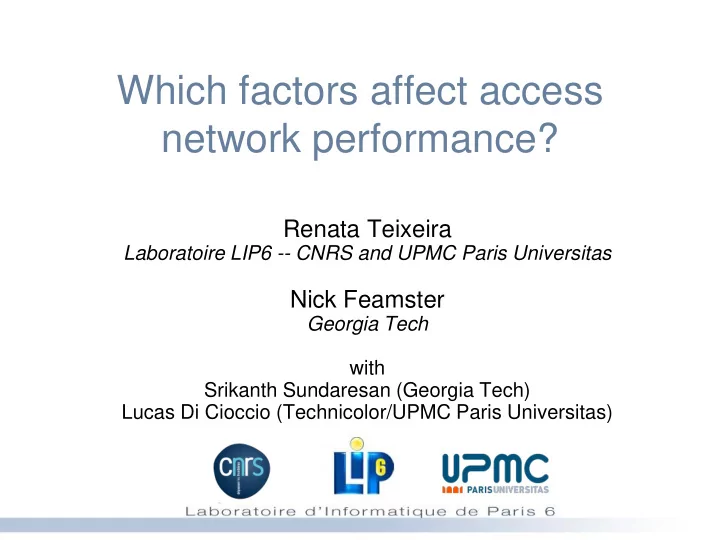

Which factors affect access network performance? Renata Teixeira Laboratoire LIP6 -- CNRS and UPMC Paris Universitas Nick Feamster Georgia Tech with Srikanth Sundaresan (Georgia Tech) Lucas Di Cioccio (Technicolor/UPMC Paris Universitas)
Motivation DSL and cable are wide-spread – But, we know little about these networks End-users – Which ISP should I pick? Which SLA? – Does my performance matches my SLA? Designers of networked applications/services – How to avoid paths with simultaneous degradation? Data to answer these questions is hard to get 1
French residential access and grenoui Clients run at home computers Orange – Pings – FTP download/upload Free – Metadata: ISP, SLA, rest of and city Internet Neuf Server reports “weather conditions” Numericable of each ISP 2
The grenouille data represents a unique opportunity Measurements taken directly from the home Measurements contain metadata from users – ISP, SLA, city Large dataset – 4.5 months of data from Jan. to June 2009 – 7,149 unique users – All big cities and ISPs in France 3
But, there are some catches Measurements from clients are not continuous – Only measure when users are online Measurements are coarse – Measurements every 30 minutes – Average of 10 pings Limited set of measurements – Can only use FTP/ping Clients measure one or two hosts only – Single destination host for all pings and FTP uploads – Each ISP has a destination host for FTP download 4
A new grenouille New client – Modular, easy to plug in new measurements – More control over destination list Collaborative grenouille – Clients can’t communicate directly – Server coordinates measurements from clients http://cmon.grenouille.com 5
Studied questions Does performance match the SLA? Which factors affect user performance? How does performance correlate across time? 6
Does performance match SLA? Cumulative fraction of users Fewer than half of the users achieve 80% of advertised SLA 95 th percentile of download speeds / advertised SLA 7
Does performance match SLA? Cumulative fraction of users Sometimes performance is better than advertised – Limit imposed by shaping (some SLAs) – Some bursts can go higher 95 th percentile of download speeds / advertised SLA 8
Other observations Uploads are more consistent than downloads – Performance is closer to advertised SLA – Advertised upload capacities are lower • Between 128 kbps and 2 Mbps Ability to match SLA depends on the SLA – Lower rates are easier to match 9
Recommend
More recommend